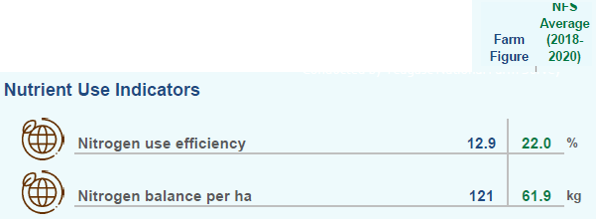Soil Fertility
James received his Sustainability Report for 2021 which was compiled by the National Farm Survey on behalf of the Signpost Programme.
The National Farm Survey has been conducted on an annual basis since 1972. The survey is operated as part of the Farm Accountancy Data Network of the EU and fulfils Ireland’s statutory obligation to provide data on farm output, costs and income to the European Commission. A random, nationally representative sample, of between 1,000 and 1,200 farms depending on the year, is selected annually in conjunction with the Central Statistics Office (CSO). Each farm is assigned a weighting factor so that the results of the survey are representative of the national population of farms.
From the information gathered from the participating farms farm specific figures can be generated for a variety of sustainability metrics which are specific to each farm.
Two figures which are particularly relevant for James’s farm are the Nitrogen Use Efficiency figure and the nitrogen balance figure.
The Nitrogen Use Efficiency (NUE) is the quantity of nutrient recovered by a crop relative to the nutrients supplied from soil, applied fertilisers, manures and ultimately how much is recovered in the end product that is sold in terms of milk, meat or crops. Efficient use of nitrogen is essential to achieving maximum grass/crop growth and achieving a greater return on each kg of fertiliser you invest in. Planning helps to optimise the use of farm nutrients, maintain and improve soil health, reduce excessive nutrient build up and lessen environmental losses.
James’s figure is 12.9% and the target is 35% so there is huge scope for improvement on the farm. As the farm is still in the development stages this is expected to improve over time. Achieving this will indicate improved sustainability of our farming systems in three ways:
- Improved usage of N inputs (fertiliser, feed) will save money on input costs (financial sustainability)
- It will benefit water quality as improved nitrogen usage will reduce the risk of nitrogen losses to water (environmental sustainability)
- Reduced fertiliser usage will also reduce ammonia emissions thus improving air quality (environmental sustainability)
James is taking the following steps on his farm to help improve his NUE:
- The whole farm was soil sampled and a nutrient management plan was put in place which gives recommended lime, slurry and chemical fertiliser application rates to build soil fertility
- Monitoring soil temperatures and weather conditions before spreading fertiliser in spring to ensure maximum uptake of nutrients
- Ensuring heavy or prolonged rain is not forecast when spreading fertiliser/slurry and not spreading if ground conditions are poor
- Adhering to buffer zones
- Using LESS (Low Emission Slurry Spreading) which increases the amount of N recovered for slurry and allows for a reduction in applied fertiliser N
- Calibrating his fertiliser spreader which makes sense financially and environmentally
In the coming years as soil fertility improves on the farm, James may consider incorporating white clover into his grazing paddocks to increase animal performance and to reduce chemical nitrogen requirements on the farm.
The other figure which is linked to NUE is the Nitrogen balance or surplus. This is calculated by subtracting the total nitrogen outputs (kg beef) from the total nitrogen inputs into the farm (ration, fertiliser). The figure for James’s farm is 121 kg N/ha and the national average of the NFS was 61.9 kg N/ha. A higher nitrogen balance indicates higher potential of leaching. This can be improved in line with NUE by less nitrogen coming into the farm (improving soil fertility, more effective feeds and fertiliser) and more nitrogen out (in the form of beef through more efficient cattle). Nitrogen leaching can be reduced by good timing of fertiliser applications, good grazing practices and using protected urea instead of CAN which James is also doing.



